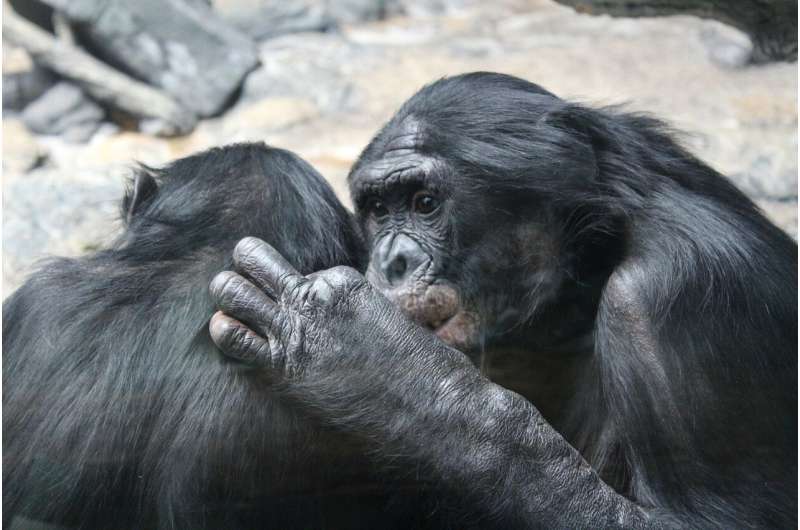Animals can't talk like humans do—here's why the hunt for their languages has left us empty-handed

Gaby Clark
scientific editor

Andrew Zinin
lead editor

Why do humans have language and other animals apparently don't? It's one of the most enduring questions in the study of mind and communication. Across all cultures, humans use richly expressive languages built on complex structures, which let us talk about the past, the future, imaginary worlds, moral dilemmas and mathematical truths. No other species does this.
Yet we are fascinated by the idea that animals might be more similar to us than it seems. We delight in the possibility that dolphins tell stories or that apes can ponder the future. We are social and thinking creatures, and we love to see our reflection in others. That deep desire may have influenced the study of animal cognition.
Over the past two decades, studies of thinking and language in animals, especially those highlighting similarities with human abilities, have flourished in academia and attracted extensive media coverage. A wave of recent studies reflects a growing momentum.
Two recent papers, both in top-tier journals, focus on our closest relatives: and . They claim these apes combine vocalizations in ways that suggest a capacity for compositionality, a key feature of human language.
In simple terms, compositionality is the capacity to combine words and phrases into complex expressions, where the overall meaning derives from the meanings of the parts and their order. It is what allows a finite set of words to generate an infinite range of meanings. The idea that great apes might do something similar has been presented as a potential breakthrough, hinting that the roots of language may lie deeper in our evolutionary past than we thought.
But there is a catch: combining elements is not enough. A fundamental aspect of compositionality in human language is that it is productive. We do not just reuse a fixed set of combinations; we generate new ones, effortlessly. A child who learns the word "wug" without having heard it before, applying rules to unfamiliar elements.
That flexible creativity gives language its vast expressive power. Yet while animal calls can be combined, nobody has observed animals doing this to create new meanings in an open-ended productive manner. They don't scale into the layered meanings that human language achieves. In short: there are no wugs in the wild.
The sequence hypothesis
Rather than chasing grammar in animals, a more grounded approach asks what cognitive difference might explain the gap we observe between humans and other animals. One is the , developed by researchers at the in Stockholm, to which we are both connected. It proposes that humans have a unique ability to recognize and remember the exact sequential order of events or elements—including words in language.
provide strong evidence that non-human animals, , represent order only approximately. For example, recent experiments with bonobos, including the , show that in 2,400 trials, these apes did not learn to distinguish a sequence of yellow and blue from a sequence of blue and yellow on a screen.
Humans, on the other hand, instantly grasp this difference. This capacity enables us to understand unknown compositional linguistic expressions like "wug killer" and "killer wug," a shift in sequence that flips meaning entirely.
Recent theoretical studies using artificial intelligence (AI) have shown that recognizing and remembering sequences may allow not only for distinguishing short expressions like "killer wug" and "wug killer," but also for and that enable open-ended compositionality from linguistic input during learning.
This kind of mental precision does not just power language. It changes how we see the world, breaking experience into far more distinct situations. But a richer world is also a more complex one to learn because the number of possible combinations explodes.
This in the co-evolution of human mental capacities and our unusually long childhood. The learning costs that come with sequence memory may explain why no other animal has taken this path.
This isn't to exclude all other species entirely here. The between implies that the two groups . We cannot exclude that cultural and linguistic abilities evolved before the common ancestor of modern humans and neanderthals, more than half a million years ago.
Animal communication
If the sequence hypothesis is correct, then in non-human animals are often being inferred from behaviors that may be explained by simpler, well-studied learning mechanisms. If so, a bonobo combining gestures or a bird eliciting a sequence of calls reflect clever learning and instinct, but not true compositional meaning.
If animals cannot represent sequences faithfully—and we see no evidence that they can—many apparent parallels with human language fall apart. The temptation to see ourselves in animals is strong, especially when their behavior seems familiar. But surface resemblance does not necessarily imply the same underlying mechanisms.
If animals have more language-like capacities than suggested here, a relevant question is why these similarities are so difficult to detect. After decades of research on dolphin intelligence and communication in larger whales, for instance, we still cannot communicate with them using any language-like code.
None of this means animals are not intelligent or that their communication is not sophisticated. Some their more efficiently. about the direction, distance to and quality of nectar sources. for communicating about various predatory threats.
Animals have evolved rich and effective ways to interact and survive in a hostile world. As a matter of fact, suggests that in a world without language, non-human great apes and pigeons would learn more efficiently and thus have greater chances of survival than a human.
Nonetheless, we see no signs of their communication stretching flexibly across time and space or building up networks of abstract concepts in the way human language does. If we want to reach a better understanding of the fascinating communication systems of other animals, perhaps humans are not the best model.
Provided by The Conversation
This article is republished from The Conversation under a Creative Commons license. Read the original article.![]()

















